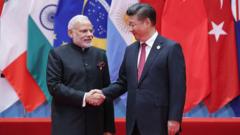India's hair industry, once overlooked, is undergoing significant changes as the demand for wigs surges. With a rich history of exporting human hair, key players like Kolachi Venkatesh and companies like Diva Divine Hair are pushing for innovation and recognition, highlighting the need for local investment to capture a larger share of the global market.
The Golden Harvest: India's Hair Industry Sees Transformation and Rising Demand

The Golden Harvest: India's Hair Industry Sees Transformation and Rising Demand
Exploring the evolution of hair collection and wig-making in India, where once discarded locks now represent a thriving industry.
In recent years, the hair industry in India has undergone a remarkable transformation, as the previous stigma surrounding wigs gives way to evolving beauty standards and increased acceptance. Zeeshan Ali, a Mumbai-based drag artist, utilizes approximately 45 wigs in his performances, reflecting his journey of self-expression and validation in the vibrant world of Indian drag culture.
Ali recounts the hardships he faced in sourcing wigs during his early career, marking a striking contrast to today's landscape where wigs appeal not only to performers but also to a burgeoning audience of mainstream consumers. This shift in perception is a vital component of a broader trend where wigs and hairpieces are now celebrated as fashion statements rather than mere accessories.
India remains a key player in the global wig market, being the largest exporter of human hair, contributing approximately 85% to global supply. One individual capitalizing on this demand is Kolachi Venkatesh from Avadi, Chennai. After 20 years in the business, he continues the legacy of his parents, collecting hair from households and salons. “What is often treated as waste is practically gold,” he states, emphasizing the inherent value of non-Remy hair sourced from various locations.
Despite the rich fabric of the industry, workers in the hair collection sector often struggle to earn a sustainable livelihood. Pickers earn merely between $0.59 and $6 a day as they gather between 1-5 kilograms, perpetuating a cycle of poverty despite their significant contributions to a billion-dollar global market. Intermediaries control pricing, leaving insufficient returns for those at the bottom of the supply chain.
The Indian hair collected primarily travels to China, where it is transformed into high-quality wigs, thus raising concerns about Indian manufacturers falling behind. According to Benjamin Cherian from Plexconcil, enhancing India's capacity with advanced technologies and investment could help the nation assert itself in the lucrative hair industry. “We could be selling wigs worth thousands rather than just exporting hair for hundreds,” he emphasizes.
Innovative companies such as Diva Divine Hair, established in Delhi by Nidhi Tiwari, are making strides by producing high-quality hair extensions and wigs. Tiwari notes a growing acknowledgment of hair loss issues among Indian women, thus highlighting the need for high-standards in wig production. As societal attitudes shift, wigs are becoming proud aspects of personal expression.
Additionally, projects in the high-end market focus on premium Remy hair, which is carefully collected from Hindu temples. George Cherion, of Raj Hair International, champions the quality of this harvested hair, emphasizing its superior alignment and processing to maintain its natural beauty.
In this evolving landscape, voices like Zeeshan Ali advocate for more accessible, innovative wig designs that captivate consumers while also making them affordable. The narrative of hair in India is not just about aesthetics; it encompasses cultural reverberations and economic opportunities awaiting recognition.



















